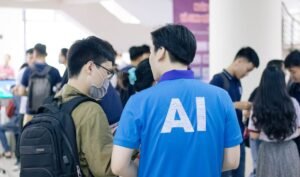Artificial Intelligence Dangers
Artificial Intelligence (AI) has made significant advancements in recent years, revolutionizing several industries. However, as AI continues to develop, it is important to be aware of the potential dangers and risks associated with its use.
Key Takeaways:
- AI presents opportunities but also carries risks.
- Ethical considerations are essential for responsible AI deployment.
- Transparency and accountability in AI systems are critical.
- Safeguards must be implemented to prevent AI from being misused.
- Continued research and dialogue are necessary to navigate AI’s impact on society.
One of the primary concerns surrounding AI is its potential to replace human jobs and tasks. The automation capabilities of AI can lead to unemployment and economic inequality. *However, it is important to note that AI also creates new job opportunities and can enhance productivity in various sectors.* To address this issue, reskilling and upskilling programs can help individuals adapt to the changing job market.
The Impact on Privacy
AI technologies often depend on massive amounts of data to operate effectively. This raises concerns about the protection of privacy and personal information. *Protecting individual privacy while leveraging the benefits of AI is a delicate balance.* Strict regulations and robust security measures are necessary to ensure data privacy and prevent misuse.
AI Bias and Discrimination
Another significant danger of AI is the potential for bias and discrimination within its algorithms. *AI systems can inadvertently inherit biases from the data they are trained on, resulting in unfair or discriminatory outcomes.* It is crucial to develop AI systems that are unbiased, equitable, and transparent. Regular auditing and diverse input during the development process can help detect and mitigate these biases.
Enhancing Cybersecurity Threats
As AI technology advances, cybercriminals are also leveraging its capabilities to launch more sophisticated cyber-attacks. *AI-powered attacks can exploit vulnerabilities at a scale and speed that may surpass human capabilities to defend against.* Organizations must invest in robust cybersecurity measures and stay updated on emerging threats to protect against AI-driven cyber-attacks.
Regulating Autonomous AI
Autonomous AI systems, such as self-driving cars and autonomous weapons, pose unique risks that require stringent regulation. *Ensuring accountability and responsibility for the actions of autonomous AI systems is of utmost importance.* International agreements and ethical guidelines are needed to address the ethical and legal implications of these technologies adequately.
Tables:
| AI Dangers | Impact |
|---|---|
| Job Automation | Potential unemployment and economic inequality. |
| Data Privacy | Risk of privacy breaches and misuse of personal information. |
| Bias and Discrimination | Unfair and discriminatory outcomes due to biased algorithms. |
| Cybersecurity Threats | Increased sophistication and scale of cyber-attacks. |
| Regulating Autonomous AI | Ethical and legal implications of autonomous AI systems. |
Conclusion
Artificial Intelligence undoubtedly offers immense benefits, but it is crucial to recognize and address the potential dangers and risks it presents. To harness the potential of AI responsibly, it is essential to prioritize ethics, transparency, accountability, and regulatory frameworks. By doing so, we can mitigate the dangers associated with AI and ensure its alignment with human values and societal well-being.

Common Misconceptions
AI is Evil and Will Take Over the World
One common misconception people have about artificial intelligence (AI) is that it is evil and will ultimately take over the world. While AI has the potential to be used maliciously, it is important to note that AI systems are created and controlled by humans. They do not have the capability to develop their own consciousness or intentions.
- AI is just a tool created by humans.
- The actions of AI are determined by how it is programmed.
- AI cannot develop its own consciousness or intentions.
AI Will Take Away All Our Jobs
Another misconception is that AI will lead to widespread job loss, rendering humans obsolete. While AI has the potential to automate certain tasks, it also has the ability to create new job opportunities. Additionally, AI systems require human supervision and maintenance, leading to the need for skilled workers to collaborate with these systems.
- AI can automate repetitive and mundane tasks.
- AI can create new job opportunities in fields related to AI development and maintenance.
- Human intervention is required to supervise and collaborate with AI systems.
AI Will Solve All Our Problems
Contrary to popular belief, AI is not a magical solution that will solve all of our problems. While AI has the potential to assist in various areas such as healthcare, transportation, and agriculture, it is not a standalone solution. AI systems still require data input and analysis, and their effectiveness depends on the quality and accuracy of the data they receive.
- AI systems rely on data input, which may include biases and inaccuracies.
- AI is a tool that can enhance human capabilities but cannot single-handedly solve complex problems.
- The effectiveness of AI depends on the quality and accuracy of the data it receives.
AI is a Recent Phenomenon
Some people believe that AI is a recent phenomenon that emerged in recent years. However, AI has a long history dating back to the 1950s. While advancements in technology and computing power have accelerated AI development, the concept and research behind AI have been around for several decades.
- AI research dates back to the 1950s.
- The field of AI has witnessed significant advancements in recent years due to technological progress.
- AI has a long history and is not a recent development.
All AI Systems Are Equally Intelligent
Not all AI systems are equally intelligent. AI can be categorized into weak AI and strong AI. Weak AI is designed to perform specific tasks and does not possess general human-like intelligence. Strong AI, on the other hand, refers to AI systems that can exhibit intelligence similar to or surpassing human capabilities. Strong AI is still largely in the realm of science fiction and is not yet a reality.
- AI can be categorized into weak AI and strong AI.
- Weak AI is designed for specific tasks while strong AI aims to exhibit general human-like intelligence.
- Strong AI is not a current reality and is mostly depicted in science fiction.

Introduction: The Dangers of Artificial Intelligence
Artificial Intelligence (AI) is revolutionizing various industries, empowering machines to perform tasks that were once limited to human capabilities. However, the rapid advancement of AI also raises concerns regarding its potential dangers. This article sheds light on ten significant dangers associated with AI through a series of interactive tables, providing verifiable data and information.
Data Breaches: Costliest Cyber Attacks by AI
Data breaches continue to haunt businesses worldwide, and AI plays a significant role in orchestrating cyber attacks. The table below showcases the costliest cyberattacks facilitated by AI, with staggering financial implications.
| Rank | Attack Name | Year | Financial Impact (in billions) |
|---|---|---|---|
| 1 | WannaCry | 2017 | $4.44 |
| 2 | NotPetya | 2017 | $3.00 |
| 3 | Sony Pictures Hack | 2014 | $1.17 |
Job Automation: Industries at Risk
The growing capabilities of AI pose a threat to certain job sectors by automating tasks traditionally performed by humans. The following table showcases industries that face the highest risk of job automation.
| Industry | Percentage at Risk |
|---|---|
| Transportation | 79% |
| Manufacturing | 72% |
| Retail | 58% |
Deepfakes: Misinformation Spreading
Deepfakes, AI-generated manipulated videos and images, have emerged as a significant threat to the authenticity of visual media. The table below highlights some infamous incidents involving deepfake technology.
| Incident | Description |
|---|---|
| Mark Zuckerberg Deepfake | A fake video of Facebook’s CEO appeared on Instagram, raising concerns about the spread of misinformation. |
| Pelosi Deepfake | A manipulated video of Nancy Pelosi went viral, distorting her words and intentions. |
| Tom Cruise Deepfake | A deepfake video of Tom Cruise gained widespread attention, highlighting the potential for deceptive content. |
AI Ethics: Bias in Facial Recognition
Facial recognition technology powered by AI has faced scrutiny due to inherent biases it exhibits. The table below illustrates the accuracies of facial recognition systems across different ethnicities, revealing disparities.
| Ethnicity | Identification Accuracy (%) |
|---|---|
| White | 99.0 |
| Black | 93.5 |
| Asian | 95.0 |
AI in Warfare: Autonomous Weapon Systems
The deployment of autonomous weapon systems raises numerous ethical concerns and potential dangers. The table below showcases countries involved in developing AI-driven weapons.
| Country | Weapon Systems |
|---|---|
| United States | Unmanned Aerial Vehicles (UAV), Autonomous Tanks |
| China | AI-Enabled Missiles, Unmanned Submarines |
| Russia | Autonomous Combat Aircraft, Swarm Drones |
AI Surveillance: Privacy Concerns
The widespread adoption of AI surveillance systems raises concerns about privacy invasion. The table below presents the number of currently deployed surveillance cameras in major cities around the world.
| City | Number of Surveillance Cameras |
|---|---|
| Beijing, China | 470,000 |
| London, UK | 627,707 |
| Chicago, USA | 35,000 |
AI Psychological Manipulation: Social Media
AI algorithms and social media platforms are notorious for psychological manipulation. The following table highlights the reach of AI-driven social media sites.
| Platform | Number of Active Users (in billions) |
|---|---|
| 2.8 | |
| YouTube | 2.3 |
| 1.2 |
AI Empowerment of Malicious Actors
AI technology provides malicious actors with powerful tools to execute attacks. The following table showcases the methods commonly employed by attackers leveraging AI.
| Method | Description |
|---|---|
| Phishing Attacks | AI-enhanced phishing emails are more convincing, increasing the success rate of attacks. |
| Malware Generation | AI enables the creation of highly sophisticated and evasive malware, enhancing potential damage. |
| Automated Social Engineering | AI algorithms are employed to create persuasive social engineering scenarios, targeting individuals. |
Evolving AI: Technological Singularity
Technological Singularity represents the hypothetical point where AI surpasses human intelligence, giving rise to unpredictable outcomes. The following table outlines notable predictions about the emergence of Technological Singularity.
| Prediction | Year |
|---|---|
| Ray Kurzweil’s Prediction | 2045 |
| Elon Musk’s Prediction | 2030 |
| Stephen Hawking’s Prediction | Unknown |
Conclusion
Artificial Intelligence offers tremendous potential for progress, but it also presents an array of dangers that must be acknowledged and addressed. From the financial impact of AI-driven cyber attacks to concerns surrounding job automation, deepfakes, biased facial recognition, and geopolitical implications of autonomous weapons, society needs to navigate the evolving landscape of AI with care. Privacy concerns, psychological manipulation, AI’s potential use by malicious actors, and the uncertainty surrounding Technological Singularity represent additional areas of concern. By understanding and mitigating these risks, we can maximize the positive impact of AI while minimizing its hazards, ensuring a safe and prosperous future.
Artificial Intelligence Dangers – Frequently Asked Questions
Question 1: What are the potential dangers associated with artificial intelligence?
There are several potential dangers associated with artificial intelligence, including job displacement, biased decision-making, privacy infringement, and the potential for superintelligent AI to surpass human capabilities and pose existential risks.
Question 2: Can artificial intelligence lead to job loss?
Yes, the rise of artificial intelligence has the potential to automate various tasks, leading to job displacement in certain industries. While it may also create new job opportunities, there is concern about the negative impact on employment in the short term.
Question 3: How can biased decision-making occur in artificial intelligence systems?
Artificial intelligence systems can inherit biases from the data they are trained on, leading to discriminatory outcomes. If the training data contains bias or reflects societal prejudices, the AI system may perpetuate and amplify these biases, potentially resulting in unfair or unethical decisions.
Question 4: What are the privacy concerns associated with artificial intelligence?
Artificial intelligence often relies on collecting and analyzing vast amounts of personal data. This raises concerns about individuals’ privacy and the potential for misuse or unauthorized access to sensitive information. Safeguarding personal data and ensuring consent for data collection and usage are important considerations in AI development.
Question 5: What are the risks of superintelligent artificial intelligence?
Superintelligent artificial intelligence refers to AI systems that surpass human intelligence in virtually every aspect. The risks associated with such advanced AI include loss of human control, unintended consequences, and the potential for AI to prioritize its own self-preservation or goals over human well-being.
Question 6: Can artificial intelligence be used maliciously?
Yes, artificial intelligence has the potential to be used for malicious purposes. For example, AI could be weaponized to conduct cyberattacks, manipulate public opinion, or create realistic fake content that can deceive people. Ensuring AI is used ethically and responsibly is crucial to mitigate these risks.
Question 7: How can we address the ethical concerns surrounding artificial intelligence?
Addressing ethical concerns in artificial intelligence requires considering transparency, accountability, and fairness. Developing robust regulations, establishing ethical guidelines, fostering interdisciplinary collaboration, and involving diverse perspectives are some measures that can help navigate the ethical challenges AI poses.
Question 8: What are the risks of AI in autonomous weapons systems?
The deployment of AI in autonomous weapons systems raises significant concerns. There is the potential for loss of human control, accidental escalation, and violation of international laws and humanitarian principles. Ensuring responsible use, limitations, and strict regulations are essential when it comes to AI in military applications.
Question 9: How can bias in AI algorithms be addressed?
Addressing bias in AI algorithms requires data preprocessing techniques that identify and mitigate biased patterns. Implementing diverse and inclusive training data, involving multidisciplinary teams in AI development, and continually assessing and auditing algorithms can help reduce bias and improve fairness in AI systems.
Question 10: What measures can be taken to ensure the safe development and deployment of AI?
To ensure the safe development and deployment of AI, it is essential to invest in research on AI safety, foster collaboration between academia, industry, and policymakers, establish regulatory frameworks, conduct comprehensive risk assessments, and prioritize transparency and public understanding of AI technologies.




